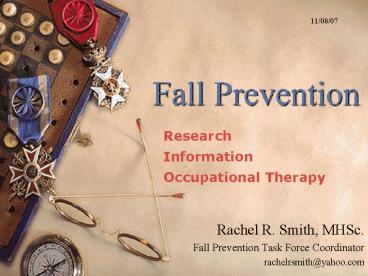Fall Prevention - PowerPoint PPT Presentation
1 / 16
Title:
Fall Prevention
Description:
11/08/07 Fall Prevention Research Information Occupational Therapy Rachel R. Smith, MHSc. Fall Prevention Task Force Coordinator rachelrsmith_at_yahoo.com – PowerPoint PPT presentation
Number of Views:1207
Avg rating:3.0/5.0
Title: Fall Prevention
1
Fall Prevention
11/08/07
Research Information Occupational Therapy
- Rachel R. Smith, MHSc.
- Fall Prevention Task Force Coordinator
- rachelrsmith_at_yahoo.com
2
Program Overview
- Resources
- National Local Data
- Risk Factors
- Assessment Tools
- Evidence Based Prevention Strategies
- Case Study OT Techniques
3
Colleagues
- Arvind Modawal, MD MPH AGSF MRCGP
- Hope J. Bard, OTR/L
4
Mission
- Reduce the number of falls and fall-related
injuries in older adults through community
collaboration.
5
Task ForceActivities Resources
- Fall prevention Task Force Members
- Awareness/Education Work Group
- Community Outreach
- Research Work Group
- Best Practices Evidence Based Strategies
- Website www.fallpreventiontaskforce.org
- Provides Fall Prevention tools, links, local
resources tips for Senior Adults, Families,
Care Givers, and Health Care providers.
6
Objective
- Identify falls to be the leading cause of
incidence of falls/year injury related
hospitalizations death among adults over 65.
7
National Fall Data
- One out of every three adults aged 65 years and
older fall each year - 20 of fall related deaths occur among the 5
of senior adults who live in a nursing home - Leading cause of ER visits among people over 65
- Am. Academy of Family Physicians report, falls
are the primary cause of injury related deaths in
people over the age of 65.
8
Cost of Falls
- Direct costs for all fall related injuries total
19.2 billion (2000) - Direct and indirect costs expected to reach 43.8
billion by 2020 (before inflation adjustment) - Average cost of a fall injury in 1998 was 19,440
(adults over 72) - 42 of fallers reduce their activity after a fall
and - 40-70 live in fear of falling again
9
Local Data
- 14 of the population in Hamilton Co.
is over 65, which accounted for - 84 of fall deaths
- 68 of fall hospitalizations
- 3rd leading cause of injury death in senior
adults in the county - Source Hamilton County Injury Surveillance
System, 2005
10
(No Transcript)
11
Falls in Nursing Homes
- Typical 100 bed nursing homes report 100-200
falls annually - As many as 75 of residents fall annually
- Residents generally more frail
- Greatest risk of falling within 1st
- week of arriving
- Common fall locations
- Bedroom-getting out of bed
- Bathroom
- Open living areas
12
Severity of Falls
Nursing Homes
- 10-20 falls cause serious injuries
- 95 of hip fractures due to falls
- Wrist arm fractures
- Bruises, sprains, joint dislocations
- Serious head injuries
- Spinal cord injuries possible
13
Senior Perspective on Falling
- Loss of independence
- Lack of support to make changes
- Denial of limitations/ functional problems
- Falls are accidents and not associated with
risk factors - Natural Part of Aging
- People are too busy to deal w/my concerns.
14
Fear of Falling
- Common among senior adults
- Reduces independence and mobility
- Becomes a cycle
- Physical Therapists and Occupational Therapists
can help
15
Common Causes of Falling
- Weakness, walking or gait problems
- Environmental hazards
- Health Conditions
- Medications
- Other Risk Factors
Non-environmental risk factors increase
significantly after the age of 70!
16
Fall Prevention
- Understand falling is often the result of many
complex interconnected risk factors - internal
- external
- multifaceted interventions in order to be
successful. - tailored program to the patients' needs because
risk factors vary among patients - Assessment tools
- Encourage Regular Examinations Physical
Activity - Referrals

